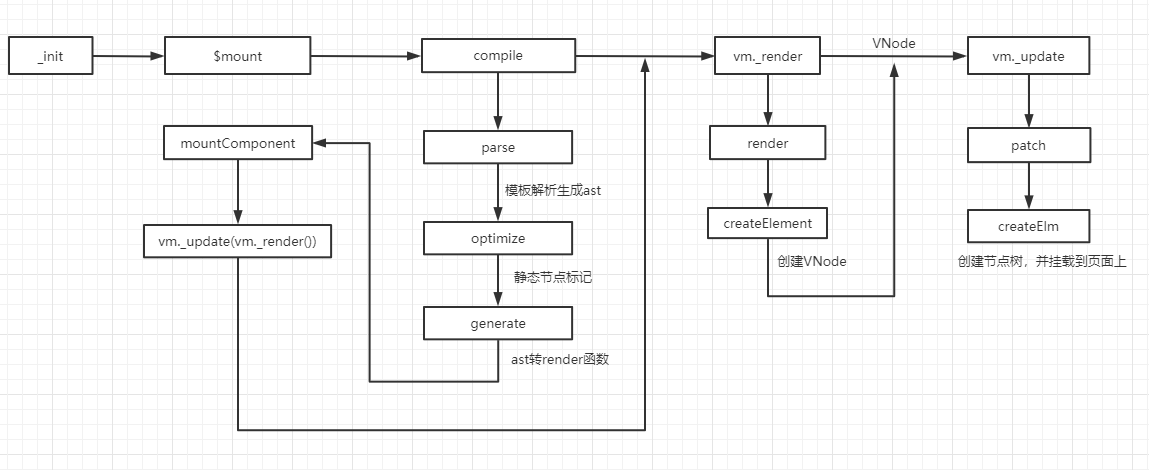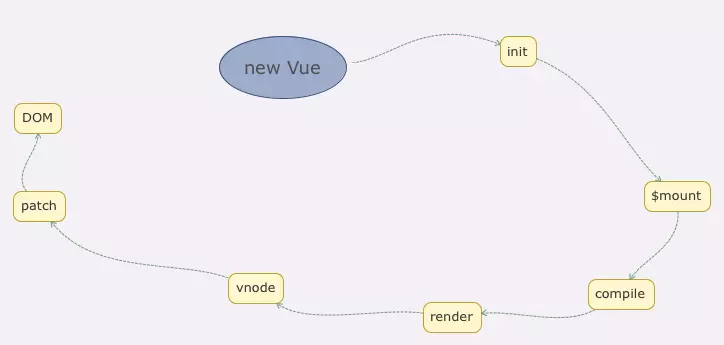前言:
本篇主要内容来自以下文章
下文是上面这些文章的个人整理与总结,然后加上自己 标注(加粗、加色),以方便记忆。
在搭建 vue 项目时,有某些组件没必要多次渲染,所以需要将组件在内存中进行‘持久化’,此时 <keep-alive> 便可以派上用场了。 <keep-alive> 可以使被包含的组件状态维持不变,即便是组件切换了,其内的状态依旧维持在内存之中。
前面整理过《vue keep-alive(1):vue router如何保证页面回退页面不刷新?,具体具体用法这里不提,这里来把 keep-live 又弯掰直,深入 理解
keep-alive 是什么(基本概念宣讲)
keep-alive 是 Vue 的内置的一个抽象组件。
什么是组件
组件系统是 vue 的另一个重要概念,它是一种抽象,允许我们使用小型、独立和通常可复用的组件构建大型应用,因此,几乎任意类型的应用界面都可以看成一个组件树:

vue界面与组件
组件的作用既可以从父作用域将数据传到子组件,也可以将把组件内部的数据发送到组件外部,可以实现互相传送数据
7 种定义组件模板的方法
字符串(String)
模板字符串(Template literal)
X-Templates
内联(Inline)
Render 函数(Render functions)
JSX
单文件组件(Single page components)
这知识举例,一般都是用单文件组件
抽象组件
不会在 DOM 树中渲染(真实或者虚拟都不会),不会渲染为一个 DOM 元素,也不会出现在父组件链中——你永远在 this.$parent 中找不到
它有一个属性 abstract 为 true,表明是它一个抽象组件
export default { name: 'abstractCompDemo', abstract: true, //标记为抽象组件}
复制代码
这个特性,我就把当 react 的 HOC 高阶组件来用(不知道对不?)
抽象组件是如何忽略掉父子关系
Vue 组件在初始化阶段会调用 initLifecycle,里面判断父级是否为抽象组件,如果是抽象组件,就选取抽象组件的上一级作为父级,忽略与抽象组件和子组件之间的层级关系。
// 源码位置: src/core/instance/lifecycle.js 32行export function initLifecycle (vm: Component) { const options = vm.$options
// locate first non-abstract parent let parent = options.parent if (parent && !options.abstract) { while (parent.$options.abstract && parent.$parent) { parent = parent.$parent } parent.$children.push(vm) } vm.$parent = parent // ...}
复制代码
如果 keep-alive 存在多个子元素,keep-alive 要求同时只有一个子元素被渲染。
keep-alive 组件怎么跳过生成 DOM 环节?
组件实例建立父子关系会根据 abstract 属性决定是否忽略某个组件。在 keep-alive 中,设置了 abstract: true,那 Vue 就会跳过该组件实例。
最后构建的组件树中就不会包含 keep-alive 组件,那么由组件树渲染成的 DOM 树自然也不会有 keep-alive 相关的节点了。
抽象组件代表:
<keep-alive>、<transition>、<transition-group>等组件
只需把封装的功能 在组件外面包裹一层就够了,这个用起来还是非常舒服的。比如节流、防抖、拖拽、权限控制等,都可以以这种形式去封装。
keep-alive 组件
keep-alive 是一个抽象组件,使用 keep-alive 包裹动态组件时,会缓存不活动的组件实例,而不是销毁它们。
keep-alive 不仅仅是能够保存页面/组件的状态这么简单,它还可以避免组件反复创建和渲染,有效提升系统性能。总的来说,keep-alive 用于保存组件的渲染状态。
keep-alive props
include 定义缓存白名单,keep-alive 会缓存命中的组件;
exclude 定义缓存黑名单,被命中的组件将不会被缓存;
max 定义缓存组件上限,超出上限使用 LRU 的策略置换缓存数据。
LRU 是内存管理的一种页面置换算法。
LRU 缓存策略
(Least recently used,最近最少使用)缓存策略:从内存中找出最久未使用的数据置换新的数据.算法根据数据的历史访问记录来进行淘汰数据,其核心思想是如果数据最近被访问过,那么将来被访问的几率也更高。
如果一个数据在最近一段时间没有被访问到,那么在将来它被访问的可能性也很小。也就是说,当限定的空间已存满数据时,应当把最久没有被访问到的数据淘汰。
keep-alive 缓存机制便是根据 LRU 策略来设置缓存组件新鲜度,将很久未访问的组件从缓存中删除。
keep-alive 源码浅析
keep-alive.js 内部还定义了一些工具函数,我们按住不动,先看它对外暴露的对象
// src/core/components/keep-alive.jsexport default { name: 'keep-alive', abstract: true, // 判断当前组件虚拟dom是否渲染成真实dom的关键 props: { include: patternTypes, // 缓存白名单 exclude: patternTypes, // 缓存黑名单 max: [String, Number] // 缓存的组件 }, created() { this.cache = Object.create(null) // 缓存虚拟dom this.keys = [] // 缓存的虚拟dom的键集合 }, destroyed() { for (const key in this.cache) { // 删除所有的缓存 pruneCacheEntry(this.cache, key, this.keys) } }, mounted() { // 实时监听黑白名单的变动 this.$watch('include', val => { pruneCache(this, name => matched(val, name)) }) this.$watch('exclude', val => { pruneCache(this, name => !matches(val, name)) }) },
render() { // 先省略... }}
复制代码
可以看出,与我们定义组件的过程一样,先是设置组件名为 keep-alive,其次定义了一个 abstract 属性,值为 true。这个属性在 vue 的官方教程并未提及,却至关重要,后面的渲染过程会用到。
在组件开头就设置 abstract 为 true,代表该组件是一个抽象组件。抽象组件,只对包裹的子组件做处理,并不会和子组件建立父子关系,也不会作为节点渲染到页面上。
props 属性定义了 keep-alive 组件支持的全部参数。
keep-alive 在它生命周期内定义了三个钩子函数:
created
初始化两个对象分别缓存 VNode(虚拟 DOM)和 VNode 对应的键集合
destroyed
删除 this.cache 中缓存的 VNode 实例。我们留意到,这不是简单地将 this.cache 置为 null,而是遍历调用 pruneCacheEntry 函数删除。
// src/core/components/keep-alive.js 43行function pruneCacheEntry ( cache: VNodeCache, key: string, keys: Array<string>, current?: VNode) { const cached = cache[key] if (cached && (!current || cached.tag !== current.tag)) { cached.componentInstance.$destroyed() // 执行组件的destroy钩子函数 } cache[key] = null remove(keys, key)}
复制代码
删除缓存的 VNode 还要对应组件实例的 destory 钩子函数
mounted
在 mounted 这个钩子中对 include 和 exclude 参数进行监听,然后实时地更新(删除)this.cache 对象数据。pruneCache 函数的核心也是去调用 pruneCacheEntry
pruneCache
function pruneCache (keepAliveInstance: any, filter: Function) { const { cache, keys, _vnode } = keepAliveInstance for (const key in cache) { const cachedNode: ?VNode = cache[key] if (cachedNode) { const name: ?string = getComponentName(cachedNode.componentOptions) if (name && !filter(name)) { pruneCacheEntry(cache, key, keys, _vnode) } } }}
复制代码
matches
判断缓存规则,可以得知 include 与 exclude,值类型可以是 字符串、正则表达式、数组
function matches (pattern: string | RegExp | Array<string>, name: string): boolean { if (Array.isArray(pattern)) { return pattern.indexOf(name) > -1 } else if (typeof pattern === 'string') { return pattern.split(',').indexOf(name) > -1 } else if (isRegExp(pattern)) { return pattern.test(name) } return false}
复制代码
pruneCacheEntry
pruneCacheEntry 负责将组件从缓存中删除,它会调用组件 $destroy 方法销毁组件实例,缓存组件置空,并移除对应的 key。
function pruneCache (keepAliveInstance: any, filter: Function) { const { cache, keys, _vnode } = keepAliveInstance for (const key in cache) { const cachedNode: ?VNode = cache[key] if (cachedNode) { const name: ?string = getComponentName(cachedNode.componentOptions) if (name && !filter(name)) { pruneCacheEntry(cache, key, keys, _vnode) } } }}
复制代码
keep-alive 在 mounted 会监听 include 和 exclude 的变化,属性发生改变时调整缓存和 keys 的顺序,最终调用的也是 pruneCacheEntry。
render
render 是核心,所以放在最后讲。简要来说,keep-alive 是由 render 函数决定渲染结果。
在开头会获取插槽内的子元素,调用 getFirstComponentChild 获取到第一个子元素的 VNode——如果 keep-alive 存在多个子元素,keep-alive 要求同时只有一个子元素被渲染。所以在开头会获取插槽内的子元素,调用 getFirstComponentChild 获取到第一个子元素的 VNode。
接着判断当前组件是否符合缓存条件,组件名与 include 不匹配或与 exclude 匹配都会直接退出并返回 VNode,不走缓存机制。
匹配条件通过会进入缓存机制的逻辑,如果命中缓存,从 cache 中获取缓存的实例设置到当前的组件上,并调整 key 的位置将其放到最后(LRU 策略)。如果没命中缓存,将当前 VNode 缓存起来,并加入当前组件的 key。如果缓存组件的数量超出 max 的值,即缓存空间不足,则调用 pruneCacheEntry 将最旧的组件从缓存中删除,即 keys[0] 的组件。之后将组件的 keepAlive 标记为 true,表示它是被缓存的组件。
render () { const slot = this.$slots.defalut const vnode: VNode = getFirstComponentChild(slot) // 找到第一个子组件对象 const componentOptions : ?VNodeComponentOptions = vnode && vnode.componentOptions if (componentOptions) { // 存在组件参数 // check pattern const name: ?string = getComponentName(componentOptions) // 组件名 const { include, exclude } = this if (// 条件匹配,不匹配直接退出 // not included (include && (!name || !matches(include, name)))|| // excluded (exclude && name && matches(exclude, name)) ) { return vnode } const { cache, keys } = this // 定义组件的缓存key const key: ?string = vnode.key === null ? componentOptions.Ctor.cid + (componentOptions.tag ? `::${componentOptions.tag}` : '') : vnode.key if (cache[key]) { // 已经缓存过该组件 vnode.componentInstance = cache[key].componentInstance remove(keys, key) keys.push(key) // 调整key排序 } else { cache[key] = vnode //缓存组件对象 keys.push(key) if (this.max && keys.length > parseInt(this.max)) { //超过缓存数限制,将第一个删除 pruneCacheEntry(cahce, keys[0], keys, this._vnode) } } vnode.data.keepAlive = true //渲染和执行被包裹组件的钩子函数需要用到 } return vnode || (slot && slot[0])}
复制代码
总结:
获取 keep-alive 包裹着的第一个子组件对象及其组件名;
如果 keep-alive 存在多个子元素,keep-alive 要求同时只有一个子元素被渲染。所以在开头会获取插槽内的子元素,调用 getFirstComponentChild 获取到第一个子元素的 VNode。
根据设定的黑白名单(如果有)进行条件匹配,决定是否缓存。不匹配,直接返回组件实例(VNode),否则执行第三步;
根据组件 ID 和 tag 生成缓存 Key,并在缓存对象中查找是否已缓存过该组件实例。如果存在,直接取出缓存值并更新该 key 在 this.keys 中的位置(更新 key 的位置是实现 LRU 置换策略的关键),否则执行第四步;
在 this.cache 对象中存储该组件实例并保存 key 值,之后检查缓存的实例数量是否超过 max 设置值,超过则根据 LRU 置换策略删除最近最久未使用的实例(即是下标为 0 的那个 key)
最后并且很重要,将该组件实例的 keepAlive 属性值设置为 true。
Vue 的渲染过程中 keep-live 分析
借助一张图看下 Vue 渲染的整个过程:

张图描述了 Vue 视图渲染的流程.png
概括来说

vue渲染过程图
VNode 构建完成后,最终会被转换成真实 dom,而 patch 是必经的过程。
Vue 的渲染是从图中 render 阶段开始的,但 keep-alive 的渲染是在 patch 阶段,这是构建组件树(虚拟 DOM 树),并将 VNode 转换成真正 DOM 节点的过程。
简单描述从 render 到 patch 的过程
我们从最简单的 new Vue 开始:
import App from './App.vue'new Vue({render: h => h(App)}).$mount('#app')
复制代码
Vue 在渲染的时候先调用原型上的_render 函数将组件对象转化成一个 VNode 实例;而_render 是通过调用 createElement 和 createEmptyVNode 两个函数进行转化;
createElement 的转化过程会根据不同的情形选择 new VNode 或者调用 createComponent 函数做 VNode 实例化;
完成 VNode 实例化后,这时候 Vue 调用原型上的_update 函数把 VNode 渲染成真实 DOM,这个过程又是通过调用 patch 函数完成的(这就是 patch 阶段了)
用一张图表达:

vue渲染过程流程图
keep-alive 包裹的组件是如何使用缓存的?
在 patch 阶段,会执行 createComponent 函数:
// src/core/vdom/patch.js 210行function createComponent (vnode, insertedVnodeQueue, parentElm, refElm) { let i = vnode.data if (isDef(i)) { // isReactivated 标识组件是否重新激活 isDef =(v)=>v !== undefined && v !== null const isReactivated = isDef(vnode.componentInstance) && i.keepAlive if (isDef(i = i.hook) && isDef(i = i.init)) { i(vnode, false /* hydrating */) } // after calling the init hook, if the vnode is a child component // it should've created a child instance and mounted it. the child // component also has set the placeholder vnode's elm. // in that case we can just return the element and be done. if (isDef(vnode.componentInstance)) { // initComponent 将 vnode.elm 赋值为真实dom initComponent(vnode, insertedVnodeQueue) // insert 将组件的真实dom插入到父元素中。 insert(parentElm, vnode.elm, refElm) if (isTrue(isReactivated)) { reactivateComponent(vnode, insertedVnodeQueue, parentElm, refElm) } return true } }}
复制代码
在首次加载被包裹组件时,组件还没有初始化构造完成,vnode.componentInstance 的值是 undefined,keepAlive 的值是 true。因此 isReactivated 值为 false。因为 keep-alive 组件作为父组件,它的 render 函数会先于被包裹组件执行;那么就只执行到 i(vnode, false /* hydrating */),后面的逻辑不再执行;
再次访问被包裹组件时,vnode.componentInstance 的值就是已经缓存的组件实例,那么会执行 insert(parentElm, vnode.elm, refElm)逻辑,这样就直接把上一次的 DOM 插入到了父元素中。
init 函数
init 函数进行组件初始化,它是组件的一个钩子函数:
// 源码位置:src/core/vdom/create-component.jsconst componentVNodeHooks = { init (vnode: VNodeWithData, hydrating: boolean): ?boolean { if ( vnode.componentInstance && !vnode.componentInstance._isDestroyed && vnode.data.keepAlive ) { // kept-alive components, treat as a patch const mountedNode: any = vnode // work around flow componentVNodeHooks.prepatch(mountedNode, mountedNode) } else { const child = vnode.componentInstance = createComponentInstanceForVnode( vnode, activeInstance ) child.$mount(hydrating ? vnode.elm : undefined, hydrating) } }, // ...}
复制代码
createComponentInstanceForVnode 内会 new Vue 构造组件实例并赋值到 componentInstance,随后调用 $mount 挂载组件。
reactivateComponent
function reactivateComponent (vnode, insertedVnodeQueue, parentElm, refElm) { let i // hack for #4339: a reactivated component with inner transition // does not trigger because the inner node's created hooks are not called // again. It's not ideal to involve module-specific logic in here but // there doesn't seem to be a better way to do it. let innerNode = vnode while (innerNode.componentInstance) { innerNode = innerNode.componentInstance._vnode if (isDef(i = innerNode.data) && isDef(i = i.transition)) { for (i = 0; i < cbs.activate.length; ++i) { cbs.activate[i](emptyNode, innerNode) } insertedVnodeQueue.push(innerNode) break } } // unlike a newly created component, // a reactivated keep-alive component doesn't insert itself insert(parentElm, vnode.elm, refElm) }
function insert (parent, elm, ref) { if (isDef(parent)) { if (isDef(ref)) { if (nodeOps.parentNode(ref) === parent) { nodeOps.insertBefore(parent, elm, ref) } } else { nodeOps.appendChild(parent, elm) } } }
复制代码
所以在初始化渲染中,keep-alive 将 A 组件缓存起来,然后正常的渲染 A 组件。
缓存渲染
当切换到 B 组件,再切换回 A 组件时,A 组件命中缓存被重新激活。
再次经历 patch 过程,keep-alive 是根据插槽获取当前的组件,那么插槽的内容又是如何更新实现缓存?

20210629213212878769093.png
// src/core/vdom/patch.js 714行const isRealElement = isDef(oldVnode.nodeType)if (!isRealElement && sameVnode(oldVnode, vnode)) { // patch existing root node patchVnode(oldVnode, vnode, insertedVnodeQueue, null, null, removeOnly)}
复制代码
非初始化渲染时,patch 会调用 patchVnode 对比新旧节点。
// 源码位置:src/core/vdom/patch.jsfunction patchVnode ( oldVnode, vnode, insertedVnodeQueue, ownerArray, index, removeOnly) { // ... let i const data = vnode.data if (isDef(data) && isDef(i = data.hook) && isDef(i = i.prepatch)) { i(oldVnode, vnode) } // ...
复制代码
patchVnode 内会调用钩子函数 prepatch。
// 源码位置: src/core/vdom/create-component.jsprepatch (oldVnode: MountedComponentVNode, vnode: MountedComponentVNode) { const options = vnode.componentOptions const child = vnode.componentInstance = oldVnode.componentInstance updateChildComponent( child, options.propsData, // updated props options.listeners, // updated listeners vnode, // new parent vnode options.children // new children )},
复制代码
updateChildComponent 就是更新的关键方法,它里面主要是更新实例的一些属性:
// 源码位置:src/core/instance/lifecycle.jsexport function updateChildComponent ( vm: Component, propsData: ?Object, listeners: ?Object, parentVnode: MountedComponentVNode, renderChildren: ?Array<VNode>) { // ...
// Any static slot children from the parent may have changed during parent's // update. Dynamic scoped slots may also have changed. In such cases, a forced // update is necessary to ensure correctness. const needsForceUpdate = !!( renderChildren || // has new static slots vm.$options._renderChildren || // has old static slots hasDynamicScopedSlot ) // ... // resolve slots + force update if has children if (needsForceUpdate) { vm.$slots = resolveSlots(renderChildren, parentVnode.context) vm.$forceUpdate() }}
Vue.prototype.$forceUpdate = function () { const vm: Component = this if (vm._watcher) { // 这里最终会执行 vm._update(vm._render) vm._watcher.update() }}
复制代码
从注释中可以看到 needsForceUpdate 是有插槽才会为 true,keep-alive 符合条件。首先调用 resolveSlots 更新 keep-alive 的插槽,然后调用 $forceUpdate 让 keep-alive 重新渲染,再走一遍 render。因为 A 组件在初始化已经缓存了,keep-alive 直接返回缓存好的 A 组件 VNode。VNode 准备好后,又来到了 patch 阶段。
function createComponent (vnode, insertedVnodeQueue, parentElm, refElm) { let i = vnode.data if (isDef(i)) { const isReactivated = isDef(vnode.componentInstance) && i.keepAlive if (isDef(i = i.hook) && isDef(i = i.init)) { i(vnode, false /* hydrating */) } // after calling the init hook, if the vnode is a child component // it should've created a child instance and mounted it. the child // component also has set the placeholder vnode's elm. // in that case we can just return the element and be done. if (isDef(vnode.componentInstance)) { initComponent(vnode, insertedVnodeQueue) insert(parentElm, vnode.elm, refElm) if (isTrue(isReactivated)) { reactivateComponent(vnode, insertedVnodeQueue, parentElm, refElm) } return true } }}
复制代码
A 组件再次经历 createComponent 的过程,调用 init。
const componentVNodeHooks = { init (vnode: VNodeWithData, hydrating: boolean): ?boolean { if ( vnode.componentInstance && !vnode.componentInstance._isDestroyed && vnode.data.keepAlive ) { // kept-alive components, treat as a patch const mountedNode: any = vnode // work around flow componentVNodeHooks.prepatch(mountedNode, mountedNode) } else { const child = vnode.componentInstance = createComponentInstanceForVnode( vnode, activeInstance ) child.$mount(hydrating ? vnode.elm : undefined, hydrating) } },}
复制代码
这时将不再走 $mount 的逻辑,只调用 prepatch 更新实例属性。所以在缓存组件被激活时,不会执行 created 和 mounted 的生命周期函数。
回到 createComponent,此时的 isReactivated 为 true,调用 reactivateComponent:
function reactivateComponent (vnode, insertedVnodeQueue, parentElm, refElm) { let i // hack for #4339: a reactivated component with inner transition // does not trigger because the inner node's created hooks are not called // again. It's not ideal to involve module-specific logic in here but // there doesn't seem to be a better way to do it. let innerNode = vnode while (innerNode.componentInstance) { innerNode = innerNode.componentInstance._vnode if (isDef(i = innerNode.data) && isDef(i = i.transition)) { for (i = 0; i < cbs.activate.length; ++i) { cbs.activate[i](emptyNode, innerNode) } insertedVnodeQueue.push(innerNode) break } } // unlike a newly created component, // a reactivated keep-alive component doesn't insert itself insert(parentElm, vnode.elm, refElm)}
复制代码
最后调用 insert 插入组件的 dom 节点,至此缓存渲染流程完成。
keep-live 钩子函数
一般的组件,每一次加载都会有完整的生命周期,即生命周期里面对应的钩子函数都会被触发,为什么被 keep-alive 包裹的组件却不是呢?
只执行一次钩子函数
一般的组件,每一次加载都会有完整的生命周期,即生命周期里面对应的钩子函数都会被触发,为什么被 keep-alive 包裹的组件却不是呢?
因为被缓存的组件实例会为其设置 keepAlive = true,而在初始化组件钩子函数中:
// src/core/vdom/create-component.jsconst componentVNodeHooks = { init (vnode: VNodeWithData, hydrating: boolean): ?boolean { if ( vnode.componentInstance && !vnode.componentInstance._isDestroyed && vnode.data.keepAlive ) { // kept-alive components, treat as a patch const mountedNode: any = vnode // work around flow componentVNodeHooks.prepatch(mountedNode, mountedNode) } else { const child = vnode.componentInstance = createComponentInstanceForVnode( vnode, activeInstance ) child.$mount(hydrating ? vnode.elm : undefined, hydrating) } } // ...}
复制代码
可以看出,当 vnode.componentInstance 和 keepAlive 同时为 truly 值时,不再进入 $mount 过程,那 mounted 之前的所有钩子函数(beforeCreate、created、mounted)都不再执行。
可重复的 activated
在 patch 的阶段,最后会执行 invokeInsertHook 函数,而这个函数就是去调用组件实例(VNode)自身的 insert 钩子:
// src/core/vdom/patch.js function invokeInsertHook (vnode, queue, initial) { if (isTrue(initial) && isDef(vnode.parent)) { vnode.parent.data.pendingInsert = queue } else { for (let i = 0; i < queue.length; ++i) { queue[i].data.hook.insert(queue[i]) // 调用VNode自身的insert钩子函数 } } }
复制代码
再看 insert 钩子:
// src/core/vdom/create-component.jsconst componentVNodeHooks = { // init() insert (vnode: MountedComponentVNode) { const { context, componentInstance } = vnode if (!componentInstance._isMounted) { componentInstance._isMounted = true callHook(componentInstance, 'mounted') } if (vnode.data.keepAlive) { if (context._isMounted) { queueActivatedComponent(componentInstance) } else { activateChildComponent(componentInstance, true /* direct */) } } // ...}
复制代码
在这个钩子里面,调用了 activateChildComponent 函数递归地去执行所有子组件的 activated 钩子函数:
// src/core/instance/lifecycle.jsexport function activateChildComponent (vm: Component, direct?: boolean) { if (direct) { vm._directInactive = false if (isInInactiveTree(vm)) { return } } else if (vm._directInactive) { return } if (vm._inactive || vm._inactive === null) { vm._inactive = false for (let i = 0; i < vm.$children.length; i++) { activateChildComponent(vm.$children[i]) } callHook(vm, 'activated') }}
复制代码
相反地,deactivated 钩子函数也是一样的原理,在组件实例(VNode)的 destroy 钩子函数中调用 deactivateChildComponent 函数。


















评论